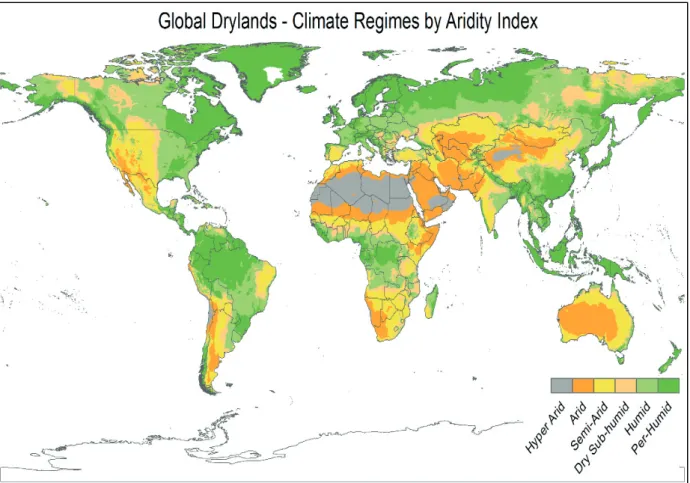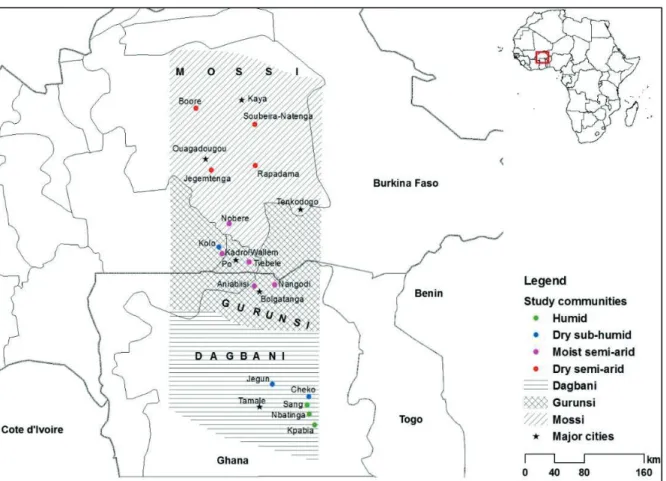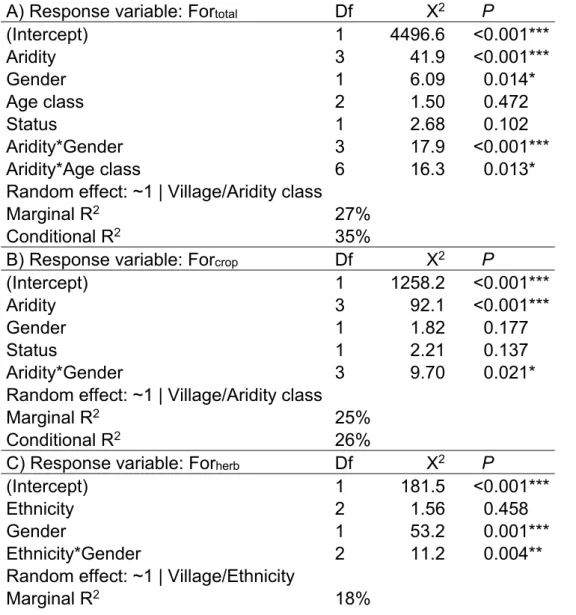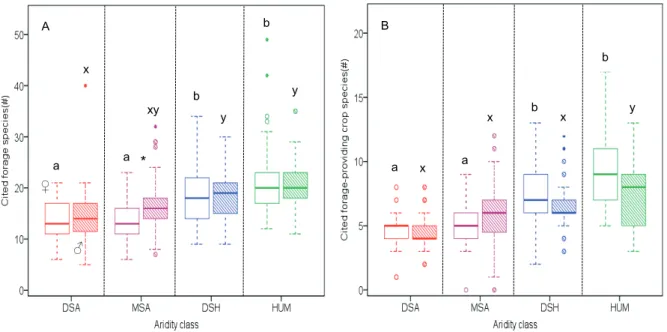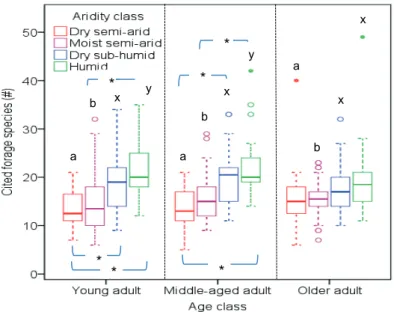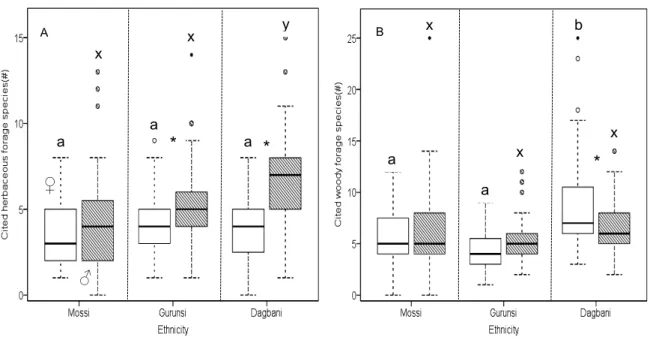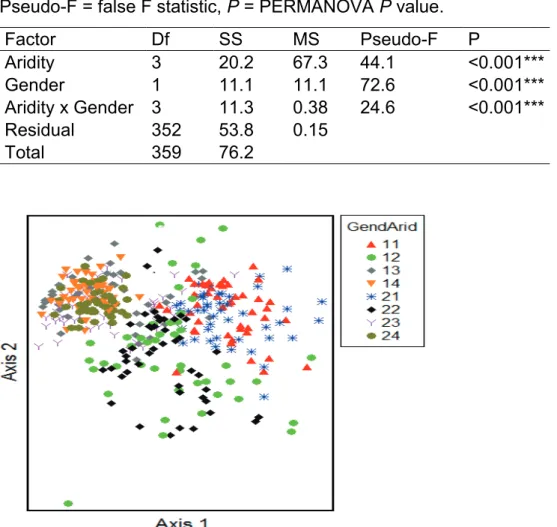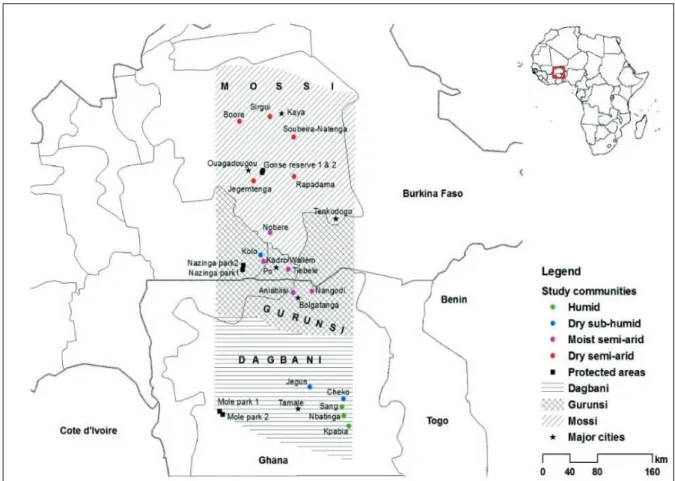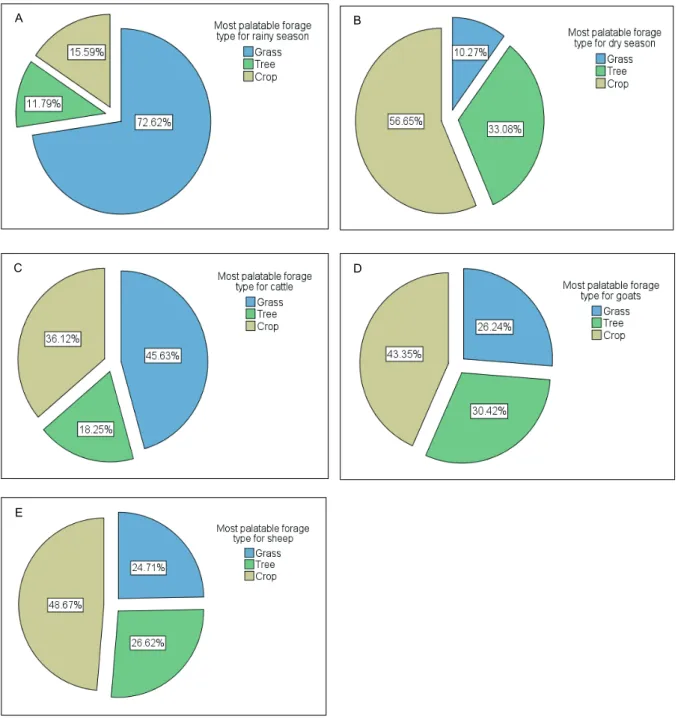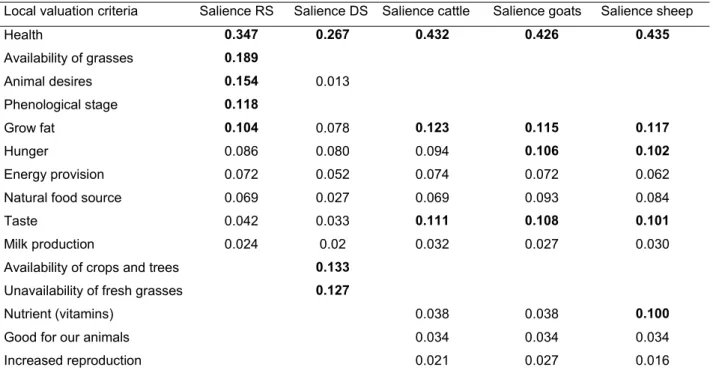Towards an understanding and harnessing of local ecological knowledge of forage resources for sustainable rangeland
management in West Africa’s Sudanian Savannas
Inaugural - Dissertation
zur
Erlangung des Doktorgrades (Dr. rer. nat.)
der Mathematisch-Naturwissenschaftlichen Fakultät der Universität zu Köln
vorgelegt von
John-Baptist S. Naah Ngmaadaba aus Kawu, Ghana
Köln, 2016
'ĞĚƌƵĐŬƚŵŝƚ'ĞŶĞŚŵŝŐƵŶŐĚĞƌDĞĚŝnjŝŶŝƐĐŚĞŶ&ĂŬƵůƚćƚĚĞƌhŶŝǀĞƌƐŝƚćƚnjƵ<ƂůŶϮϬϭ7
Berichterstatter:
Prof. Dr. Boris Braun PD Dr. Anja Linstädter
Vorsitz der Prüfung:
Prof. Dr. Guenter Schwarz
Beisitzer:
Dr. Holger Kretschmer
Tag der letzten mündlichen Prüfung: 28. November 2016.
"Adhering to a daily schedule that is led by your vision and run by your priorities is the
surest path to personal freedom." – Mark Ford
i Dedication
This dissertation is dedicated to:
x My wife: Rosemary Naah, and
x Children: Terence N. Naah, Gabriel Y. Naah and Michelle N. Naah,
………for their immense understanding, love and patience during my field
visits, data analysis and write-up stages of this thesis document.
ii General abstract
Despite the fact that dryland savanna ecosystems provide a host of essential ecosystem goods and services to both humans and livestock, they are often confronted with dangerously vacillating levels of locally available natural resources to support rural livelihood strategies in the face of increasing anthropological influences and global climate change impacts. This points to the vital roles which the socio-cultural and bio- physical environment sub-systems play to ensure the stability of the complex socio- ecological system (SES). Several attempts have been made in the past to focus more on scientifically-based means of investigation than including contributions of the local resource users to better understand and harness SES. Notwithstanding, local ecological knowledge (LEK), which is an effective, investigative tool for understanding interactions between the ecological and social sub-systems of complex SES, has recently received increasing attention in studies on the effects of climate and land use changes on the availability and utilization of natural resources in communal rangelands. Surprisingly, little is still known when it comes to LEK of forage resources, particularly in the West African Sudanian Savannas.
The overarching goal of this study was to investigate local agro-pastoralists’ knowledge on forage resources used by cattle, goats and sheep and how they adapt their rangeland management strategies to vegetation dynamics. I hypothesized that LEK can potentially provide insight into reasons how and why forage resources are overexploited, and into management strategies to conserve or restore them. The study encapsulates three major empirical components: (i) LEK distributional patterns in forage resources utilization (Chapter 4), (ii) local valuation criteria for forage resources (Chapter 5), and (iii) local perceptions on forage species diversity, abundance trends, habitats distribution and ecological drivers to forage species changing trends over the past few years via the
‘lenses’ of local agro-pastoralists (Chapter 6). Using a stratified random sampling
approach, I sampled sixteen villages across three dominant socio-linguistic groups and a
steep climatic aridity gradient in both Ghana (seven villages) and Burkina Faso (nine
villages) to address the aforementioned empirical components of the study. Although
individual ethnobotanical interviews were chosen over focused or group discussions to
extract the bulk of independent primary ethnobotanical data from local agro-pastoralists,
iii
I also complemented the data collection process with personal observations and ethnobotanical walks for purposes of triangulation.
For the distributional patterns of LEK on forage resources utilization among local agro- pastoralists, this thesis examines socio-cultural and environmental variables which specifically affect various components of LEK dynamics (be it LEK on herbaceous, woody and crop-related forage plants), reflecting their capacity to recollect and list vernacular names of forage species. This section also looks at the local climatic variability implications for LEK accumulation on forage plants (Chapter 4). Furthermore, this study addresses the aspect of local valuation criteria for forage resources by agro-pastoralists.
Here, I elicited LEK on forage resources by asking them to cite and rank specific forage species mostly considered to be palatable for various domestic livestock and at different seasons. I also asked agro-pastoralists’ to provide underlying reasons for their rankings to gather more information on explicit valuation criteria for available forage resources.
This anthropological dataset was matched with ecological information obtained from rangeland vegetation sampling using 20m x 50m per plot for the woody vegetation at different topographic positions (Chapter 5). Regarding local perceptions on forage species diversity, abundance trends, habitat distributions and ecological drivers, local agro-pastoralists were interviewed to specifically answer questions relating to above- stated ecological variables (Chapter 6).
To disentangle the effects of socio-cultural and environmental variables on LEK accumulation and local explicit valuation criteria, I employed various statistical approaches such as exploratory data analyses with IBM SPSS v. 22 as well as generalized linear mixed-effects models (GLMM) with rigorous model selection procedures using the Akaike Information Criterion (AIC) with R software (Chapters 4 &
5). I also used non-metric multi-dimensional scaling (nMDS) to visualize similarities or
dissimilarities of LEK distributional patterns as well as a two-way non-parametric
permutational multivariate analysis of variance (PERMANOVA) using PC-ORD v.5 for
purposes of triangulation (Chapter 4). Also, I used ANTHROPAC 1.0 software to calculate
cognitive salience index (CSI) of both anthropological and ecological datasets. In Chapter
6, the forage species diversity metrics were estimated and other ecological variables done
iv
using descriptive statistics, bivariate correlation analysis and also performed CSI calculations.
The results of this study reveal that those who resided in villages with moist environmental conditions seem to generally exhibit superior LEK on forage resources in terms of citation of many forage species than those who situate in dry rural communities. This evidence also is true for the ability of local agro-pastoralists to provide various underlying reasons for ranking of cited forage species. It was also evident that local agro-pastoralists possessed extensive knowledge and understanding of the habitat distribution, abundance trends and effects of predominant ecological drivers in the study region. The findings of this study, therefore, contribute to the on-going scholarly debates on how LEK-oriented research is crucially important, and the need to incorporate it into the scientific approach to enhance the functional understanding of ethno-ecologically useful natural resources for sustainable development and livelihood improvement.
Key words: Agro-pastoralists; Burkina Faso; Dryland rangelands; Forage resources;
Ghana; Local ecological knowledge; Social-ecological systems; Valuation criteria.
v Zusammenfasung
Die Savannen-Ökosysteme Afrikas liefern wichtige Ökosystemdienstleistungen für Mensch und Tier. Vor dem Hintergrund der zunehmenden anthropogenen Überformung und des Klimawandels werden die entsprechenden natürlichen Ressourcen jedoch knapper, was die lokalen Überlebensstrategien der Menschen nachhaltig beeinflusst. Die sozio-kulturellen und biologisch-physischen Subsysteme der Umwelt, die eine wichtige Rolle im sozio-ökologischen System (SES) spielen, werden deshalb immer bedeutender.
In der Vergangenheit wurden verschiedene Versuche unternommen, das System der Ökosystemdienstleistungen besser zu verstehen und nutzen zu können. Jedoch lag der Fokus dieser Analysen vor allem auf wissenschaftlich begründeten (externen) Untersuchungs- und Bewertungsmethoden, während lokale Praktiken und Erfahrungen der Nutzer der Systemdienstleistungen kaum einbezogen wurden.
Ungeachtet dessen hat das Interesse an lokalem ökologischem Wissen (Local Ecological Knowledge, LEK) und dessen Erforschung in jüngster Zeit deutlich zugenommen. Nicht zuletzt ermöglicht der LEK-Ansatz ein umfassenderes Verständnis der Prozesse zwischen ökologischen und sozialen Subsystemen, etwa bei der Analyse der Auswir- kungen von Klimawandel und Landnutzungsveränderungen auf die Verfügbarkeit und Nutzbarkeit der natürlichen Ressourcen von Weideland. Von besonderem Interesse sind dabei die Savannengebiete der Sudanzone West-Afrikas. Überraschenderweise ist dort bisher allerdings erst sehr wenig Forschung über LEK im Bereich der Nahrungs- mittelressourcen betrieben worden.
Das Hauptziel dieser Arbeit liegt in der Analyse des lokal verfügbaren Wissens von Viehhaltern über die natürlichen Ressourcen der Weideländer, die für Rinder, Ziegen und Schafe genutzt werden. Darüber hinaus sind die Anpassungsstrategien in der Weidewirt- schaft in Bezug auf die Vegetationsdynamik von besonderem Interesse. Der Studie liegt die Hypothese zugrunde, dass LEK einen wichtigen Beitrag zur Erforschung der Gründe und des Ausmaßes der Überbeanspruchung von Weideland leisten kann und darüber hinaus wertvolle Ansätze zum Aufbau von nachhaltigen Ansätzen der Weidebewirt- schaftung liefert.
Die Studie setzt sich aus drei empirischen Komponenten zusammen: 1. Analyse der
Verbreitung und Anwendung von LEK bei der Nutzung von Weidelandressourcen (Kapitel
vi
4), 2. Analyse lokaler Bewertungskriterien von Weidelandressourcen (Kapitel 5) und 3.
Analyse der lokalen Wahrnehmung von Artenvielfalt, -reichtum und -verbreitung sowie der ökologischen Faktoren der Veränderungsprozesse aus Sicht von Weidelandnutzern (Kapitel 6).
Für die Analysen wurden 16 Dörfer mittels geschichteter Stichproben als Untersuchungs- gebiete ausgewählt. Diese erstrecken sich entlang der Verbreitungsräume von drei größeren sozio-linguistischen Gruppen sowie eines abnehmenden Ariditätsgradienten in Ghana (sieben Dörfer) und Burkina Faso (neun Dörfer). Für die Erhebungen wurden individuelle enthnobotanische Interviews gewählt, um eine große Fülle an ethno- botanischen Primärdaten von lokalen Viehhaltern erfassen zu können. Diese wurden durch persönliche Beobachtungen sowie ethnobotanische Begehungen ergänzt, um die gewonnen Daten triangulieren zu können. Im Rahmen dieser Dissertation wurden sowohl sozio-kulturelle als auch ökologische Variablen erhoben, um die verschiedenen Effekte der Komponenten auf die LEK-Dynamik im räumlichen Kontext erfassen zu können. LEK wird im Hinblick auf Kräuter sowie Holz- und Erntepflanzen untersucht – dabei wurden vor allem die Fähigkeiten der Menschen erhoben, einheimische Pflanzen zu lokalisieren und zu benennen. Dieser Teil der Studie untersucht auch die Implikationen der lokalen klimatischen Variabilität auf die LEK-Akkumulation in Bezug auf Weidelandpflanzen (Kapitel 4). Darüber hinaus betrachtet die Dissertation die lokalen Bewertungskriterien für Weidelandressourcen von Viehhirten. Hierfür wurde das vorhandene LEK überprüft, indem die Befragten verschiedene Pflanzenarten benennen, in eine Rangfolge bringen und nach ihrer Nutzbarkeit zur Tierernährung bewerten sollten. Zudem wurde jeweils nach einer Begründung für die Bewertung gefragt, um mehr Informationen über die ent- sprechenden Kriterien sammeln zu können. Dieser ethnologische Datensatz wurde auf Übereinstimmung mit ökologischen Faktoren untersucht. Als Grundlage hierfür wurde die Vegetationszusammensetzung für Plots von 20m x 50m in unterschiedlichen topographischen Positionen erfasst (Kapitel 5). Zudem wurden Viehhirten zu ihrer Wahrnehmungen von Diversität und Verbreitung von Weidelandpflanzen sowie den zugrunde liegenden ökologischen Einflussfaktoren befragt (Kapitel 6).
Um die sozio-kulturellen und ökologischen Effekte des LEK sowie lokale Bewertungs-
kriterien zu bestimmen, wurden mithilfe von IBM SPSS v. 22 statistische Berechnungen
vii
durchgeführt. Mit R konnten „Generalized Linear Mixed-Effects Models“ (GLMM) mit diskreten Modellauswahlprozeduren auf der Basis des Akaike Information Criterion (AIC) berechnet werden (Kapitel 4 und 5). Für die Visualisierung von Ähnlichkeiten und Unterschieden des LEK wurde eine nicht-metrische multi-dimensionale Skalierung (nMDS) sowie eine nicht-parametrische multivariate Analyse (PERMANOVA) mithilfe von PC-ORD v.5 durchgeführt. Mithilfe von ANTHROPAC 1.0 wurde der „Cognitive Salience Index“ (CSI) der ethnologischen und ökologischen Daten berechnet. In Kapitel 6 werden Messwerte für die Diversität der Weidepflanzen abgeschätzt und weitere ökologische Variablen mittels deskriptiver Statistiken, bivariater Korrelationsanalysen und CSI- Berechnungen ermittelt.
Die Ergebnisse der Studie zeigen, dass Viehhalter in Dörfern mit feuchteren Umwelt- bedingungen über mehr Wissen in Bezug auf die Benennung von Pflanzennamen verfügen als dies bei Hirten in trockeneren Gebieten der Fall ist. Dieser Unterschied wird bei der Fähigkeit der Viehhirten bestätigt, eine Begründung für ihre Bewertungskriterien von Nutzpflanzen benennen zu können. Ebenfalls ist evident, dass Viehhirten ein stark ausgeprägtes Wissen über lokal vorkommende Pflanzenarten und ihre Verbreitung haben. Zudem können sie Entwicklungen von Verbreitung und Vorkommen abschätzen sowie ökologische Faktoren hierfür benennen.
Die Ergebnisse dieser Studie leisten einen Beitrag zur fortlaufenden wissenschaftlichen Debatte um LEK-basierte Forschung. Sie bestätigen zudem die hohe Relevanz entsprechender Untersuchungen und Notwendigkeit, diese in zukünftige Ansätze zur Nachhaltigkeitsforschung einzubinden.
Schlusselwörter: Viehhalter; Burkina Faso; Ghana; Trockengebiete; Nahrungsmittel-
ressourcen; Lokales ökologisches Wissen; Sozio-Ökologische Systeme; Bewertungs-
kriterien.
viii Acknowledgements
I hereby, first of all, express my profound indebtedness to Prof. Dr. Boris Braun who took over the primary supervision of my thesis work at its advanced stage. I am very thankful to him for his academic guidance, open-mindedness, a warm welcome to his working group and provision of office space and financial support by engaging me as a graduate research assistant at the Institute of Geography. This offered me an enabling environment to be more concentrative and productive to ensure swift finalization of my thesis. I am equally thankful to my second supervisor, PD Dr. Anja Linstädter, who previously provided me a research opportunity in her working group and guided me to shape and enrich my research work. Many thanks also go to my academic tutor at the Center for Development Research (ZEF), Dr. Irit Eguaveon, for her valuable academic advice and involvement at the onset of my research process.
I also duly acknowledge the German Federal Ministry of Education and Research (BMBF) for the provision of funding for my research activities via the West African Science Service Center on Climate Change and Adapted Land-use (WASCAL; FKZ 01LG1202A). I also express my appreciation to all WASCAL staff, especially Dr. Boubacar Barry and Mr.
Boukare Ouedraogo, at the WASCAL Competence Center, Ouagadougou for logistical support. Let me also particularly thank Mr. Aaron Aduna, WASCAL coordinator at the Bolgatanga Basin, for his readiness to render logistical support and general accommodation needs despite obvious challenges during field visits in Ghana.
I would like to also convey my deepest and sincere gratitude to the dean of the graduate school at the Faculty of Mathematics and Natural Resources, Prof. Dr. Günter Schwarz, who patiently listened to my academic grievances and encouraged me with his pieces of advice to be able to finish the thesis write-up.
I also want to deeply acknowledge the following persons: Dr. Guido Lüchters, Dr. Jan Ruppert, Dr. Justice Tambo and Mr. Frederik Aust for making useful statistical inputs at the initial stages of my data analysis. Additionally, I am very thankful to Dr. Reginald T.
Guuroh for his brotherly support and constructive discussions. My interactions with these
people highly strengthened my statistical knowledge and equipped me with new skills and
experiences. I am also very grateful to Dr. Gerald Forkuor and Mr. Müller Maximilian for
editing the map of my study area and German translation of the general thesis abstract
ix
respectively. My thanks also go to all members of my new working group of Prof. Dr. Boris Braun, especially Mr. Abdullah Al-Maruf and Mr. Sebastian Fastenrath, both PhD candidates, for good company and useful discussions. I also want to take this opportunity to acknowledge the immerse institutional support received from the Université de Ouagadougou, Burkina Faso (e.g. Dr. Oumarou Ouedraogo, Mr. Cyril), regarding assistance in the identification of herbarized forage plants specimen, Ministry of Food and Agriculture (MoFA) staff in Bolgatanga office (e.g. Mr. J. B. Walier), Ghana, for information on crop and livestock production and the Senckenberg Institute staff (e.g. Dr. Marco Schmitz) at the University of Frankfurt, Germany, for confirmation of scientifically identified forage plants specimens.
My acknowledgements are not complete without the mention of local agro-pastoralists and traditional leaders (chiefs) who generously allowed me and the research team to interview them on LEK of woody-, herbaceous- and crop-related forage plants. These interviews provided a lot of insight into how ethnobotanical knowledge was popular and accumulated among the local folks. Despite a lot of inter- and intra-dialectical challenges encountered during the interview sessions, my local field assistants painstakingly performed creditably well in helping me collect the required data (both anthropological and ecological datasets) for this final thesis work. I am, therefore, highly indebted to them:
Mr. Francis-Xavier Naawaakuo, Miss Cynthia Kuubari and Mr. Simon Aboona in Ghana and Mr. Vincent Bado, Mr. Kassim Millogo, Mr. Zou Abdoul Lamine and Mr. George Kowe in Burkina Faso. I am equally grateful to Mr. Bado Romeo at the WASCAL Competence Center, Ouagadougou, for monitoring and coordinating some field interviews conducted within the Ouagadougou environs in my absence. I also thank Mrs. Abena Adu-Sarpong for her encouragements as well as Pastor Yeboah Ebenezer and Mr. Stephen Boseah for their prayers in some difficult moments encountered in the course of my study. Many thanks equally go to my parents (Mr. Yakara Naah and Mrs. Yirifaah Naah) and siblings for their immense moral support, love and prayers throughout my academic life.
Most importantly, thanks be to the almighty God for His divine guidance, blessings and
protection throughout my entire study period and in other areas of endeavor. May the
good Lord richly bless you all.
x N.B.:
I. For the three empirical Chapters of this study, two Chapters (4 & 5) have been submitted to internationally recognized scientific Journals namely Journal of Environmental Management and Agriculture, Ecosystems and Environment.
II. The two submitted manuscripts have been mainly written by the doctoral candidate (first author). The respective co-authors (Reginald T. Guuroh, Anja Linstädter and Boris Braun) made inputs before submission to Journals for consideration for publication.
III. The third empirical Chapter (6) is currently prepared in readiness for submission soon to a Journal.
IV. The doctoral candidate has been publishing under slightly different surname (Naah) instead of (Naah Ngmaadaba) reflecting in his official documents to avoid confusion in the citation of his scientific publications by other scientists.
V. The pronoun, ‘we’, is used in some Chapters to refer to the doctoral candidate and
others (co-authors).
xi Table of Contents
Dedication ... i
General abstract ... ii
Zusammenfasung... v
Acknowledgements ... viii
List of Figures ... xvii
List of Tables ... xix
Abbreviations ... xx
1 General introduction ... 1
1.1 Definition and usage of basic terminologies ... 5
1.2 Rationale for this LEK study ... 7
1.3 Research goal and specific objectives ... 8
1.4 The organizational structure of the thesis ... 8
2 Conceptual framework of this study ... 10
2.1 Global drylands: A brief overview ... 10
2.2 Social-ecological systems as conceptual framework ... 12
3 General materials and methods ... 15
3.1 Methods in rangeland vegetation ecology ... 15
3.2 Ethnobotanical methods for investigation of LEK-related studies ... 15
3.3 Broad study methodological framework ... 16
3.3.1 Ghana ... 18
3.3.2 Burkina Faso ... 21
3.3.3 Selection criteria for villages/locations ... 21
3.3.4 Voucher specimens’ collection and preparation ... 22
3.3.5 Agro-ecological zones ... 22
xii
3.3.6 Geological & pedological settings ... 23 3.3.7 Vegetation, floral, faunal and crops-related species compositions ... 24 3.3.8 Land use systems ... 24 3.4 Ethnoecological research challenges ... 25 4 Factors influencing local ecological knowledge of forage resources:
Ethnobotanical evidence from West Africa’s savanna ... 27
4.1 Chapter abstract and highlights ... 27
4.2 Introduction ... 28
4.3 Materials and methods ... 30
4.3.1 Study area within a broad regional context ... 30
4.3.2 Ethnic groups studied ... 31
4.3.3 Study design and data sampling procedures for ethnic groups, aridity classes,
gender affiliation, age groups and residential status of agro-pastoralists ... 33
4.3.4 Free list tasks ... 34
4.3.5 Ethnobotanical walks, voucher specimen collection and direct field observations
... 35
4.3.6 Data analysis ... 36
4.4 Results and discussion ... 37
4.4.1 Forage species richness and their citation frequency among local agro-
pastoralists ... 37
4.4.2 Relative importance of aridity and ethnicity in predicting LEK on forage plants
... 38
4.4.3 Effects of climatic and socio-cultural factors on forage-related LEK among agro-
pastoralists ... 39
4.4.4 Local climate change and variability implications for LEK accumulation of forage
resources ... 50
4.5 Conclusion ... 51
xiii
5 Do local agro-pastoralists have criteria for valuation of forage resources in West
African Sudanian savannas? – Using a quantitative ethnoecological approach .. 52
5.1 Chapter abstract and highlights ... 52
5.2 Introduction ... 53
5.3 Materials and methods ... 55
5.3.1 Environmental setting ... 55
5.3.2 Cultural setting ... 56
5.3.3 Study design and sampling approach ... 57
5.3.4 Ethnoecological interviews ... 58
5.3.5 Climate data collection ... 59
5.3.6 Vegetation sampling strategy ... 60
5.3.7 Voucher specimen preparation ... 60
5.3.8 Data analysis ... 61
5.4 Results and discussion ... 64
5.4.1 Seasonal and livestock-specific rankings and salience of forage species among
local agro-pastoralists ... 64
5.4.2 Salience of explicit criteria for valuating forage resources for livestock
production and management among agro-pastoralists ... 69
5.4.3 Matching CSI values of local informants’ data and ecological data on forage
species: Any point of convergence? ... 70
5.4.4 Determinants of citation of explicit valuation criteria for forage resources by local
agro-pastoralists ... 71
5.5 Conclusion ... 74
6 Assessing forage species diversity, habitat distributions, abundance trends and
ecological drivers from local agro-pastoralists’ perspectives in West Africa’s
Savanna ecosystems ... 76
6.1 Chapter abstract and highlights ... 76
xiv
6.2 Introduction ... 77
6.3 Materials and methods ... 79
6.3.1 Study area description ... 79
6.3.2 Selected ethnic groups and climatic zones ... 80
6.3.3 Ethnobotanical survey design ... 82
6.3.4 Sampling procedures for obtaining ecological information from agro-pastoralists
... 82
6.3.5 Data analysis ... 83
6.4 Results and discussion ... 85
6.4.1 Forage species diversity from species citations of local agro-pastoralists ... 85
6.4.2 Perception of agro-pastoralists on habitat distribution of forage resources ... 86
6.4.3 Agro-pastoralists’ assessment of the forage species abundance and their trends
... 87
6.4.4 Local ecological drivers to changing abundance trends of forage resources . 90
6.4.5 Forage resources conservation suggestions put forward by local agro-
pastoralists ... 91
6.5 Conclusion ... 93
7 General concluding remarks and recommendations ... 95
References ... 98
Appendices ... 116
Appendix 1: Structured questionnaire for performance of individual ethnobotanical
surveys for obtaining alternative information from local agro-pastoralists on LEK
distributional patterns, valaution criteria and local perception forage species diversity
in for both Ghana and Burkina Faso. ... 116
Appendix 2: Specific study sites and sampling overview for LEK investigation across
the delineated Climatic Zones as well as the districts or provinces in both Ghana and
Burkina Faso. ... 124
xv
Appendix 3: Summary of the ten most dominant forage species composition given by
local agro-pastoralists located in individual studied rural communities located in both
Ghana and Burkina Faso. ... 125
Appendix 4A: Post hoc tests with ethnicity-based model for significant interacting effect
between ethnicity and gender on LEK of herbaceous forage plant species. ... 128
Appendix 4B: Post hoc test with ethnicity-based model for significant interacting effect
between ethnicity and gender on LEK of woody forage plant species. ... 129
Appendix 4C: Post hoc test with aridity-based model for significant interacting effect
between aridity class and gender on total forage plant species. ... 130
Appendix 4D: Post hoc test with aridity-based model for significant interacting effect
between aridity class and gender on crop-related forage plant species. ... 131
Appendix 4E: Post hoc test with aridity-based model for significant interacting effect
between aridity class and age class on total forage plant species... 132
Appendix 5: Post hoc tests for the climatic variable significant for explained variance in
local valuation criteria for forage resources by agro-pastoralists. ... 134
Appendix 6: Performance of the superior aridity-based models for number of citations
of local valuation crtiteria for forage resources (be it rainy and dry seasons, cattle,
goats and sheep preferences as outcome variables). ... 136
Appendix 7: PCA using varimax rotation with Kaiser Normalization indicating
independent variables with high loadings for various principal components for further
analysis. ... 137
Appendix 8: Vernacular names for cover terms used by local agro-pastoralists from
different ethnic backgrounds for various forage types in the study area. ... 138
Appendix 9: Vernacular names for cover terms used by local agro-pastoralists from
different ethnic backgrounds for varied livestock types in the study area. ... 139
Appendix 10: Forage species diversity metrics for respective villages sampled in both
Ghana and Burkina Faso. ... 140
xvi
Appendix 11: Perceived local ecological drivers responsible for abundance trends in forage plants in the study region. ... 141 Appendix 12: Local conservation measures suggested by sampled agro-pastoralists in the study region. ... 143 Appendix 13: Summary of family richness obtained from the ethnobotanical interviews conducted in the research region. ... 145 Appendix 14: The 19 most frequently cited forage species by local agro-pastoralists with their respect total salience values ... 147 Note: FT=Forage type; FAll=Frequency for all forage species cited; FD=Frequency for only Dagbani ethnic group; FM=Frequency for only Mossi ethnic group; FG=
Frequency for only Guruns ethnc group. ... 147 Appendix 15: Total forage species sampled with the study areas in northern Ghana and south-central Burkina Faso. ... 148 Appendix 16: Unknown forage species sampled in both northern Ghana and south-
central Burkina Faso. ... 154
Erklärung ... 167
Curriculum Vitae... 168
xvii List of Figures
Fig. 1: Predominant domestic livestock types (I) and forage resource types (II) considered within typical West African Sudanian Savanna ecosystems. ... 5 Fig. 2: A map of global drylands illustrating various climatic regimes using the United Nations Education Program (UNEP) aridity classification systems ... 12 Fig. 3: Methodological flowchart of the ethnoecological research carried out in the West African Sudanian Savannas, specifically in northern Ghana and southern-central Burkina Faso. ... 21 Fig. 4: Study area comprising northern Ghana and south-central Burkina Faso with 15 villages across three major ethnic groups (Dagbani, Gurunsi and Mossi) located along a gradient of climatic aridity. ... 31 Fig. 5: Boxplots indicating the interacting effect of environmental harshness (aridity class) and gender on (A) respondents’ overall knowledge of forage plants (total free list length;
For
total), and (B) respondents’ quantitative knowledge of crop plants providing forage (For
crop). ... 44 Fig. 6: Interacting effects of environmental harshness (aridity class) and age (age class) on respondents’ overall knowledge of forage plants (For
total). ... 45 Fig. 7: Interacting effects of gender and cultural setting (ethnicity; with Mossi living in the more arid north, and Dagbani living in the more humid south of the study area) on (A) respondents’ quantitative knowledge of herbaceous plants (For
herb), and (B) respondents’
quantitative knowledge of woody forage plants (For
wood). ... 48 Fig. 8: Two-dimensional non-metric multi-dimensional scaling (nMDS) ordination of sample units in species spaces. ... 49 Fig. 9: Map depicting the three major ethnic groups in 16 rural communities and the climatic aridity classes located within northern Ghana and southern-central Burkina Faso.
... 57
Fig. 10: Proportions of forage plants types ranked by local farmers as most palatable or
suitable during rainy and dry seasons and for cattle, goats and sheep production. ... 67
Fig. 11: Cognitive salience indices of the 10 most commonly cited individual forage
species by agro-pastoralists in descending order in 16 villages located in Northern Ghana
and Southern Burkina Faso. ... 69
xviii
Fig. 12: Comparison of plant species composition for both the interviewed-based (A) and plot-based (B) datasets in all study sites within Northern Ghana and Southern-central Burkina Faso. ... 71 Fig. 13: Study area in the West African Sudanian savannas comprising northern Ghana and south-central Burkina Faso, and positions of 16 study villages across three major ethnic groups (Dagbani, Gurunsi and Mossi) located along a gradient of climatic aridity.
... 80
Fig. 14: Percentage of forage species citations by local agro-pastoralists based on habitat
types. ... 87
Fig. 15: Local agro-pastoralists’ perception on the abundance levels (many, few or rare)
of ten most frequently cited forage species in both Ghana and Burkina Faso. ... 88
Fig. 16: Pie chart illustrating local agro-pastoralists’ perceptions on abundance trends of
forage species in the study area. ... 89
Fig. 17: Dominantly perceived ecological drivers to forage abundance trends according
to local agro-pastoralists in the study area. ... 91
Fig. 18: The topmost local conservation measures of forage resources according to agro-
pastoralists in the study area. ... 933
xix List of Tables
Table 1: Results of final GLMMs showing how respondents’ LEK on forage plants is shaped by socio-cultural and climatic factors. ... 42 Table 2: PERMANOVA results for aridity class and gender in explaining patterns of LEK on For
total. ... 49 Table 3: The topmost 15 local valuation criteria provided by local agro-pastoralists and their respective cognitive salience indices (CSIs) for rainy season, dry season, cattle, goats and sheep. ... 70 Table 4: Aridity-based final model selection using generalized linear mixed-effects (GLMM). ... 73 Table 5: Correlation matrix illustrating various species diversity metrics for forage species cited by local agro-pastoralists resident in varied rural communities in northern Ghana and southern-central Burkina Faso. ... 86
xx Abbreviations
AEZ Agro-ecological zone AI Climatic aridity index
AIC Akaike information criterion ANOVA Analysis of variance
CI Confidence interval
Cri
cattleLocal valuation criteria for cattle
Cri
DSLocal valuation criteria in the dry season Cri
goatsLocal valuation criteria for goats
Cri
RSLocal valuation criteria in the rainy season Cri
sheepLocal valuation criteria for sheep
CSI Cognitive salience index CSOs Civil Society Organizations DSA Dry semi-arid
DSH Dry subhumid
E Species evenness
EAH Ecological apparency hypothesis
FAO United Nations Food and Agriculture Organization For
cropCrop-related forage resources
For
herbHerbaceous forage resources For
woodWoody forage resources
GLMM Generalized linear mixed-effects models H` Shannon Wiener diversity index
HUM Humid
IK Indigenous knowledge LEK Local ecological knowledge MOFA Ministry of Food and Agriculture MSA Moist semi-arid
NDVI Normalized Difference Vegetation Index
nMDS Non-metric multidimensional scaling
PCA Principal component analysis
xxi S Species richness
SDI Simpson’s diversity index SES Socio-ecological systems
SPSS Statistical Package for the Social Sciences TEK Traditional ecological knowledge
UNEP United Nations Environmental Program
WASCAL West African Science Service Center on Climate Change and Adapted Land Use
1 1 General introduction
The scientific body of literature abounds with evidences that future projections and scenarios of global climatic conditions point to increasing incidences of drought spells, overgrazing, severe temperatures and land degradation particularly in global drylands (IPCC 2007, Reynolds et al. 2007, Maestre et al. 2012, IPCC 2013), and such changes are unbeneficial (IPCC 2013). Drylands (see Section 2.1 for a detailed overview) are also well known to cover the majority of the world's poorest of the poor, including Sub-Saharan Africa, where people largely engage in rain-fed agriculture as their main source of employment, food and income (SWAC/OECD 2008). The general notion that drylands are of little value does not reflect the reality (Maestre et al. 2012). This is because, drylands are believed to provide a wide range of ecosystem goods and services for humans’ well-being in many parts of the world (MEA 2005, Maestre et al. 2012, Rinawati et al. 2013).
It is also argued that the livelihood security of the majority of people inhabiting these dryland ecosystems is largely dependent upon the provision of ecosystem services from local vegetation (Martin et al. 2016). For instance, forage services (Duru et al. 2015) serve as the most important provisioning ecosystem services in tropical savannas (Safriel and Adeel 2005). The delivery of these forage services from dryland rangelands is mainly dependent on rangelands’ floristic composition (Anderson et al. 2007, Linstädter and Baumann 2013), but modulated by other drivers such as recent precipitation (Wiegand et al. 2004, Ruppert et al. 2012). The floristic composition itself is driven by various abiotic and biotic factors, with climatic aridity being among the most prominent one on a regional scale (Linstädter et al. 2014). Hence, climate is a critical factor for the delivery of forage services, and climate change may exert a strong influence on them (Ferner et al. 2015).
In typical West African settings, continued forage availability for livestock production is highly crucial since about 45 percent of rural households (mostly practicing agro- pastoralism) heavily rely upon sources of livestock-related income (Mertz et al. 2010).
Notwithstanding, the majority of the local agro-pastoralists in this region, as in other
drylands of the globe, are often confronted with a multiplicity of other challenges such as
pests and diseases, scarcity of water and limited forage resources, high poverty levels,
2
increasing human population growth, land use pressure coupled with the negative impacts of global environmental change over the past decades (SWAC/OECD 2008). In spite of these daunting challenges usually faced by local farmers in such dry environments, they have been able to cope and adapt to the rapidly changing climatic conditions in their local vicinities for several year (Mortimore and Adams 2001).
Fortunately, negative effects of climate change on forage service delivery – and thus on local livelihoods – may be partly mitigated by an adaptive rangeland management (Martin et al. 2014). For example, management decisions can be attuned to the vulnerability of forage plants, creating rest periods in times when forage plants are particularly sensitive to grazing (Buttolph and Coppock 2004, Müller et al. 2015). To be able to do this, local agro-pastoralists have to draw upon their accumulated local wisdom from many generations to sustainably managing these limited natural forage resources for their livestock and their own survival. These considerations underline the fact that land users’
local ecological knowledge (hereafter also LEK) on forage plants is of critical importance for an adaptive rangeland management (Müller et al. 2007, Linstädter et al. 2013).
A plethora of literature shows that LEK has received growing levels of international recognition in studies on the effects of climate and land use changes, species richness and vegetation composition in communal rangelands (Berkes et al. 2000, Steele and Shackleton 2010). However, these studies mostly focused on mobility decisions (Adriansen 2008, McAllister 2010), and/or on other aspects of agro-pastoral systems, such as degradation patterns or drought management (Homann et al. 2008, Ifejika Speranza et al. 2010, Kgosikoma et al. 2012, Oba 2012).
LEK on forage plants is being considered as a crucially vital tool for understanding social-
ecological systems (SES; see Section 2.2 beneath for details). The few studies explicitly
addressing the cultural domain of forage plants come from Brazil (Nunes et al. 2015),
Ethiopia (Bahru et al. 2014), and Morocco (Linstädter et al. 2013). These studies
underline that dryland pastoralists have indeed a rich body of forage-related LEK, and
that it plays a key role for management decisions (Linstädter et al. 2013). To the best of
my knowledge, investigations regarding use of LEK on forage resources within the West
African Sudanian savannas (particularly Ghana and Burkina Faso) has been highly
under-documented and poorly understood. Not only has this research rekindles the
3
importance of LEK investigations in the context of SES generally but also serves as a stepping stone for deeper understanding of how locally available forage resources are being sustainably used over the years by local agro-pastoralists in the study area.
In this thesis, I do not only look at a limited dimension of LEK on forage resources but rather aim to explore a wide array of LEK on woody vegetation, herbaceous plants and crops (including crop residues) for sustainable domestic livestock production among small-householder agro-pastoralists inhabiting rural communities in northern Ghana and southern Burkina Faso. The most commonly farmed large- and small-stock namely cattle (Bos taurus L.), goats (Capra hircus L.) and sheep (Ovis aries L.) are considered in this study (see Fig.1). The Sudanian zone of both countries is inhabited by a large number of small ethnic groups and thus show different socio-economic conditions and different forms of natural resource management within the same agro-ecological zone.
Using stratified random sampling in my methodological approach (see Chapter 3), the villages of interest together with local informants, belonging to different dominant ethnic groups as well as gender affiliations and age categories, were meticulously chosen along a steep climatic gradient of increasing aridity from South to North (see Figs. 4, 9, 13). This was primarily done to examine and extract drivers of local agro-pastoralists’ knowledge accumulation, identify local valuation criteria for forage resources ranking and assess their knowledge perception of forage species diversity, abundance, habitat distributions and ecological drivers responsible for their changing trends along a delineated aridity gradient and variegated socio-cultural backgrounds in a typical West African settings.
I argued that LEK accumulation, valuation criteria of forage resources and local
perception of forage species diversity, distribution, abundance and ecological drivers are
differentially influenced by climate-related and socio-demographic variables. This study
also argues that local knowledge in conjunction with ecologically scientific knowledge on
available natural forage resources is of utmost importance to sustainable rural agro-
pastoralism, contributing to the on-going debate about the vital role LEK investigations
play for various aspects of natural resources management, especially in Ghana and
Burkina Faso. The output of this research is geared towards shedding some new light on
the depth of local agro-pastoralists’ LEK on the under-studied forage resources to
4
understand and harness how to effectively dialogue with local community members and
policy-makers for sustainable rural livelihood improvement.
5
Fig. 1: Predominant domestic livestock types (I) and forage resource types (II) considered within typical West African Sudanian Savanna ecosystems. Note: Livestock types considered in this study are only limited to cattle, goats and sheep, while forage resource types are not limited to those displayed in the photos.
1.1 Definition and usage of basic terminologies
To enhance the understanding of the rich LEK on forage resources used for domestic livestock from the perspective of local agro-pastoralists, I define and used the following terminologies in this thesis document:
x
Forage resources are hereby referred to a broad array of plant materials such as woody vegetation (trees and shrubs), herbaceous plants (annual- and perennial grasses and forbs) as well as crop plants (and/or crop residues) used to feed domestic livestock especially cattle, goats and sheep reared in communal rangeland settings.
x Followinng Dougill et al. (2012), rangelands refer to terrestrial ecosystems which
are constrained by environmental stressors such as droughts, fire and severe temperatures and mostly dominated by herbaceous and shrubby vegetation. With such an open savanna vegetation structure, dryland rangelands are suited for rearing of domestic livestock to make use of locally available forage resources.
Here, rangelands are largely communal grazing areas which are also fallowlands.
x
Local agro-pastoralists are those peasant farmers (including their family members) who engage in both crop farming (food and cash crops) as well as livestock husbandry (large and small domestic ruminants and poultry) for survival.
Agro-pastoralism is mostly practiced in selected villages for this study.
x
Local pastoralists are those local farmers whose household needs come from 50 percent or more livestock or animal-related products for consumption (Niamir- Fuller 1998). In the studied rural communities in northern Ghana and southern Burkina Faso, pastoralism is not strictly practiced.
x The terms “local informants”, “local respondents”, “local experts” and “local farmers”
are used in this study to depict local inhabitants who have in-depth
6
understanding and knowledge of forage plants available on their immediate environs through their own practical experiences over the years.
x
Traditional ecological knowledge (TEK) is defined as a cumulative body of traditional knowledge, practices, and beliefs via evolving adaptive processes which have been passed down from generation to generation by cultural transmission and the relationship of living organisms with their natural environment (Berkes et al. 2000).
x
Indigenous knowledge (IK) refers to the knowledge and perception of the local environment by indigenous people at a particular locality.
x
Social-ecological systems (SES) refers to the interplay between humans and their natural environment in a complex and adaptive manner. The provision of ecosystem services from the natural environment have been coupled with societal feedback in SES studies (Nassl and Löffler 2015).
x The term “local ecological knowledge (LEK)” is defined here as the experiential
